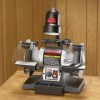Craftsman 21154 Owners Manual - Page 6
Always, Damaged, Bench, Place., Wheel, Supplied, Dresser, Wheel., Adjusting, Direction, Information - sears
 |
View all Craftsman 21154 manuals
Add to My Manuals
Save this manual to your list of manuals |
Page 6 highlights
The operation of any grinder can result in debris being thrown into your eyes, which can result in severe eye damage. ALWAYS WEAR EYE PROTECTION. Any power tool can throw debris during operations, which could cause severe and permanent eye damage. Everyday eyegtasse are NOT safety glasses. ALWAYS wear Safety Goggles (that comply with ANSI standard Z87.1) when operating power tools. Safety Goggles are available at Sears Retail Stores. Basic precautions should always be followed when using your bench grinder. To reduce the risk of injury, electrical shock, or fire, comply with the safety rules listed below: 1. ALWAYS USE THE EYE SHIELDS AND WHEEL GUARDS provided with the grinder. 2. REPLACE A CRACKED OR DAMAGED GRINDING WHEEL IMMEDIATELY. A damaged wheel can discharge debris at a high velocity towards the operator. Carefully handle the grinding wheels since they are abrasive. Prior to replacing a grinding wheel, check it for cracks. DO NOT remove the blotter or label on both sides of the grinding wheel. Tighten the spindle nut just enough to hold the grinding wheel firmly to the Bench Grinder. Do not over-tighten the nut. Excessive clamping force can damage the grinding wheel. Only use the wheel flanges provided with the grinder. When selecting a replacement grinding wheel, verify that the grinding wheel has a higher R.P.M. rating than the maximum R.P.M. of the Bench Grinder. 3. THE DIAMETER OF THE GRINDING WHEELS WILL DECREASE WiTH USE. Adjust the tool rests and spark arrestors to maintain a distance of 1/16" from the wheel. 4. DO NOT STAND IN FRONT OF THE BENCH GRINDER WHEN STARTING IT. Stand to one side of the Bench Grinder and turn it "ON". Wait at the side for one minute until the grinder comes up to full speed. There is always a possibility that debris from a damaged grinding wheel may be discharged towards the operator. 5. THE BENCH GRINDER WILL PRODUCE SPARKS AND DEBRIS DURING GRINDING OPERATIONS. Be sure that there are not any flammable materials in the vicinity. Frequently clean grinding dust from the back of the Bench Grinder. 6. NEVER FORCE THE WORKPIECE AGAINST A GRINDING WHEEL, especially if the wheel is cold. Apply the workpiece slowly, allowing the grinding wheel an opportunity to warm up. This will minimize the chance of wheel breakage. DO NOT grind using the sides of the grinding wheels. DO NOT apply coolant directly to the grinding wheel. 7. KEEP ALL WHEEL GUARDS IN PLACE. DO NOT USE THE BENCH GRINDER WITH THE WHEEL GUARDS REMOVED. 8. KEEP THE TOOL RESTS FIRMLY TIGHTENED. 9. ALWAYS USE THE SUPPLIED WHEEL DRESSER TO RESURFACE THE FACE OF THE GRINDING WHEEL. 10. REMOVE ADJUSTING KEYS AND WRENCHES. Form habit of checking to see that keys and adjusting wrenches are removed from toot before turning it on. 11. DIRECTION OF FEED. Feed work into a blade or cutter against the direction of rotation of the blade or cutter only. 12. USE RIGHT TOOL. Don't force tool or attachment to do a job for which it was not designed. 13. DO NOT overtighten wheel nut. 14. ONLY use flanges furnished with the grinder. 15. FREQUENTLY clean grinding dust from beneath grinder. 16. DO NOT FORCE THE TOOL to perform an operation for which it was not designed. It will do a safer and higher quality job by only performing operations for which the tool was intended. 17. ADDITIONAL INFORMATION regarding the safe and proper operation of this product is available from: ,, Power Tool Institute 1300 Summer Avenue Cleveland, OH 44115-2851 www.powertootinstitute.org ,, National Safety Council 1121 Spring Lake Drive Itasca, IL 60143-3201 • American National Standards Institute 25 West 43rd Street, 4th Floor New York, NY 10036 www.ansi.org • ANSI 01.1 Safety Requirements for Woodworking Machines and the U.S. Department of Labor regulations www.osha.gov 18. SAVE THESE INSTRUCTIONS. Refer to them frequently and use them to instruct others.















